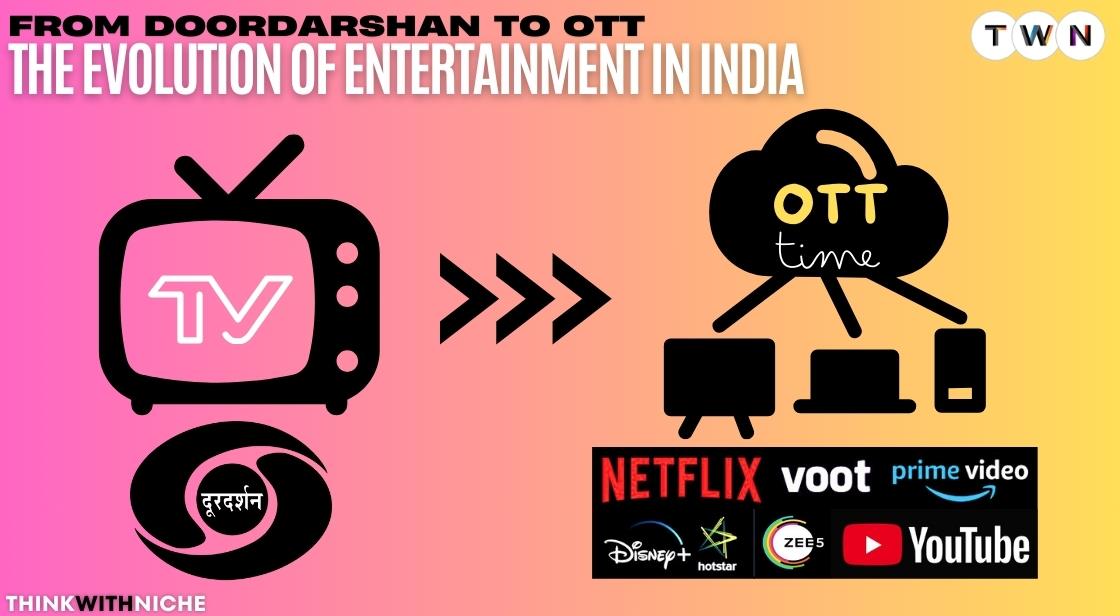From Doordarshan to OTT: The Evolution of Entertainment in India

Blog Post
The entertainment landscape in India is undergoing a monumental transformation, propelled by the relentless march of technology and shifting viewer preferences. With the advent of Over-the-Top (OTT) platforms, the way we consume media has been revolutionized, offering unparalleled choice and convenience to audiences across the country.
The narrative begins with Doordarshan, a pioneer that ushered in a new era of entertainment. While black and white broadcasts marked its early days, iconic programs like Ramayana and Krishi Darshan captured the nation's imagination and laid the groundwork for the vibrant television industry we see today.
As of the latest data available in 2024, India boasts a staggering 550 million OTT audience, a significant increase from the previous year, indicating the exponential growth of this digital phenomenon.
This surge in viewership is fueled by factors such as widespread availability of high-speed internet, the proliferation of smartphones, and competitive data tariff wars among telecom companies.
In this dynamic environment, traditional television models are facing unprecedented challenges, with OTT platforms emerging as the dominant force in the entertainment industry.
From personalized content recommendations powered by artificial intelligence to a burgeoning library of regional language offerings, the future of OTT promises a rich and immersive viewing experience tailored to individual preferences.
This article delves into the evolution of OTT in India, exploring its impact on traditional media, the rise of regional content, and the transformative trends shaping the future of entertainment consumption.
How Streaming Revolutionized Entertainment in India:The Rise of OTT in India
India's entertainment landscape has undergone a dramatic transformation. Gone are the days when viewers had just a handful of channels to choose from on Doordarshan, the national broadcaster. Today, a staggering amount of content is available at our fingertips thanks to the rise of OTT (Over-the-top) platforms. This article explores this fascinating journey, tracing the evolution of entertainment in India and the impact of OTT on traditional media.
The Era of Doordarshan: A Glimpse into India's Television Beginnings
Doordarshan, literally translating to "distant vision," wasn't just India's first national broadcaster, it was a pioneer that ushered in a new era of entertainment and information dissemination. While the year 1959 marks the official launch, the journey began a few years earlier with a pilot project.
Humble Beginnings: A Spark of Innovation (1956-1959)
The seeds of Doordarshan were sown in 1956 with the establishment of an experimental television service by All India Radio (AIR) in Delhi. This modest setup, equipped with a small transmitter and makeshift studio, aimed to gauge the potential of television in India. Just three years later, in 1959, the success of this pilot project led to the official launch of Doordarshan on September 15th.
From Black and White to Blockbusters: The Evolution of Doordarshan Programming (1959-1980s)
The early days of Doordarshan were marked by black and white broadcasts, limited to a few hours a day and accessible to only a handful of viewers. Despite these constraints, Doordarshan started shaping Indian television by introducing iconic programs that captured the nation's imagination.
-
Informative Content: Educational programs like Krishi Darshan ("Farming View") offered valuable agricultural knowledge to a largely agrarian society.
-
Musical Delights: Chitrahaar, a weekly music program with a vibrant mix of Bollywood classics and regional music, became a cultural phenomenon.
-
Epic Dramas: The 1980s witnessed the telecast of mythological epics like Ramayana and Mahabharata, captivating audiences across the country and setting a new standard for television viewership.
Expansion and Regionalization (1970s-1990s)
Doordarshan's reach gradually expanded throughout the following decades. The 1970s marked the introduction of regional channels, starting with DD Bangla in 1975. By 1993, Doordarshan boasted 11 regional channels catering to diverse linguistic communities across India. This was a significant step towards inclusivity and fostering a sense of national identity.
The Arrival of Color (1982): A Milestone for Doordarshan
A momentous occasion for Doordarshan arrived in 1982 with the live telecast of the Independence Day parade in color. This marked the official introduction of color television in India, signifying a technological leap forward and enhancing the viewing experience for audiences.
The Legacy of Doordarshan
While the media landscape has evolved significantly in recent years with the rise of satellite TV and OTT platforms, Doordarshan's legacy remains undeniable. It played a pivotal role in shaping cultural consciousness, fostering national unity, and laying the groundwork for the vibrant television industry India enjoys today.
The Arrival of Satellite TV
The Satellite Revolution: Breaking the Doordarshan Monopoly (1992)
While Doordarshan's regional expansion offered a glimpse of diversity, the real explosion of choice arrived in 1992 with the introduction of satellite television. This marked a watershed moment, shattering the monopoly Doordarshan had held for over three decades.
A Technological Leap: Ushering in a New Era
Satellite TV relied on satellites orbiting Earth to transmit signals directly to homes equipped with satellite dishes. This technology offered several advantages over traditional terrestrial broadcasting:
-
Increased Capacity: Unlike Doordarshan's limited channels, satellite technology could broadcast a much larger number of channels simultaneously.
-
Improved Signal Quality: Satellite broadcasts offered clearer and sharper picture quality compared to terrestrial transmissions.
-
Wider Reach: Satellite signals could reach remote areas not covered by Doordarshan's terrestrial network.
A Flood of Content and Diverse Voices
The arrival of satellite TV unleashed a torrent of content choices for Indian audiences. Private channels like Zee TV and Star TV entered the scene, offering a diverse range of programming:
-
Entertainment Explosion: Bollywood movies, music videos, and regional language entertainment became readily available, catering to a wider audience with varied tastes.
-
Global Exposure: International channels brought the world closer, showcasing documentaries, foreign news, and international sporting events.
-
Niche Programming: Specialized channels catering to specific interests like sports, news, music, and lifestyle emerged.
The Impact of Satellite TV on Indian Viewers
The introduction of satellite TV had a profound impact on Indian audiences:
-
Empowerment and Choice: Viewers were no longer confined to Doordarshan's pre-programmed schedules. They could now choose what they wanted to watch, when they wanted to watch it.
-
Cultural Exchange: Exposure to global content broadened viewers' perspectives and challenged traditional societal norms.
-
Consumerism: Channels bombarded audiences with advertisements, influencing purchasing decisions and fueling a consumerist culture.
The Challenge to Doordarshan
Satellite TV posed a significant challenge to Doordarshan's dominance. Faced with a plethora of options, viewers began to migrate away from Doordarshan's limited offerings. This prompted Doordarshan to adapt, launching its own satellite channels and revamping its programming strategy.
The Legacy of Satellite TV
The arrival of satellite TV in 1992 marked a turning point in the Indian media landscape. It sparked a revolution of choice, empowered viewers, and paved the way for the further evolution of entertainment with the rise of OTT platforms. While Doordarshan's influence declined, the legacy of satellite TV lies in fostering a dynamic and diverse media ecosystem in India.
Also Read: Understanding The Rise of OTT in India: 2024 Edition
The Rise of OTT Platforms in India
The OTT Revolution: A Paradigm Shift in Entertainment Consumption (2010s-Present)
The evolution of entertainment took a dramatic turn with the rise of Over-the-top (OTT) platforms in the 2010s. Unlike traditional TV, which operates on a linear schedule, OTT platforms offer a paradigm shift in viewer control:
-
On-Demand Content: Gone are the days of rigid program schedules. Viewers reign supreme, choosing what they want to watch, whenever they want, and even pausing, rewinding, or fast-forwarding at will.
-
Device Agnosticism: OTT content transcends the limitations of the television screen. Viewers can access their favorite shows and movies on smartphones, tablets, laptops, smart TVs, and even gaming consoles, offering unparalleled flexibility.
Fueling the OTT Boom: Affordability and Connectivity
Several factors propelled the meteoric rise of OTT platforms in India:
-
High-Speed Internet Penetration: The widespread availability of affordable high-speed internet connections, particularly mobile data, became the backbone of OTT streaming.
-
Smartphone Revolution: The ubiquity of smartphones as primary entertainment devices created a perfect platform for OTT consumption.
-
Data Tariff Wars: Telecom companies' competitive data tariff wars further fuelled the OTT boom by making internet access more affordable for a wider audience.
Demanding Diversity: Content Beyond the Mainstream
The success of OTT platforms hinges on the power of content:
-
The Rise of Original Content: Streaming services like Netflix, Amazon Prime Video, Disney+ Hotstar, and ZEE5 have invested heavily in producing high-quality original content, including web series, movies, and documentaries, catering to diverse tastes.
-
Regional Powerhouse: OTT platforms have recognized the immense potential of regional content. A plethora of shows and movies are now produced in various Indian languages, catering to a vast and diverse audience beyond the metros.
-
Niche Appeal: OTT platforms cater to niche interests, offering content focused on genres like animation, stand-up comedy, true crime documentaries, and international productions, previously unavailable on mainstream television.
The OTT Landscape in India: A Competitive Arena
India's OTT market is a fiercely competitive landscape with over 70 active platforms vying for viewer attention. Here are some of the leading players:
-
Global Giants: Netflix, Amazon Prime Video, and Disney+ Hotstar have leveraged their international content libraries and established brand recognition to gain a strong foothold in the Indian market.
-
Homegrown Powerhouses: Indian players like ZEE5, SonyLIV, Voot, and MX Player offer a strong mix of original content, regional programming, and library titles, catering specifically to Indian audiences.
The Impact of OTT: Reshaping the Entertainment Industry
The rise of OTT has had a profound impact on the Indian entertainment landscape:
-
Traditional TV Viewership Decline: The convenience and diversity offered by OTT platforms have led to a decline in viewership of traditional television channels, particularly among younger demographics.
-
Focus on Quality Content: The OTT boom has placed a premium on high-quality, engaging content. Production houses and studios are now creating content specifically for OTT platforms, raising the bar for storytelling and technical quality.
-
Investment and Innovation: The OTT space continues to witness significant investment, fostering innovation in areas like artificial intelligence-powered content recommendations and interactive storytelling formats.
The Future of OTT: Personalization and Data-Driven Experiences
As the OTT market matures, personalization will be key to success. Platforms will leverage user data to curate content recommendations, suggest personalized playlists, and tailor viewing experiences to individual preferences.
Furthermore, artificial intelligence (AI) will play a crucial role in analyzing audience data and predicting user behavior, allowing platforms to create content that resonates more deeply with their viewers.
The OTT Boom: Reshaping Entertainment and Beyond (with Latest Data)
The past decade has witnessed a seismic shift in Indian entertainment, with OTT platforms becoming the undisputed kings. Here's a deeper look at the OTT boom and its far-reaching impact:
A Staggering Audience and Exponential Growth: As of 2024, India boasts a colossal 550 million strong OTT audience, a significant increase from the 481.1 million reported in 2023. This meteoric rise is projected to double by 2026, solidifying OTT's dominance in the entertainment sector.
Fueling the Fire: Content is King
The surge in OTT viewership has ignited a content creation frenzy. Indian streaming services are pouring resources into original content, estimated to reach a staggering $800 million invested in 2023 alone. This investment is evident in the production of high-quality web series, movies, and documentaries, catering to diverse tastes and regional preferences.
A Bright Future: Anticipated Growth Trajectory
The Indian OTT market shows no signs of slowing down. Industry analysts predict a robust Compound Annual Growth Rate (CAGR) of 8.2% for the period 2024-2029. This signifies continued investment, innovation, and audience engagement within the OTT ecosystem.
Beyond the Digital Realm: The Impact on Traditional TV
The rise of OTT has transcended the digital sphere, impacting traditional television viewership patterns. In fact, television is the only media and entertainment segment that witnessed a decline in growth in 2023 compared to 2022. This trend is likely to continue as viewers migrate towards the on-demand control and diverse content libraries offered by OTT platforms.
Additional Considerations:
-
The Rise of Regional Content: OTT platforms have recognized the immense potential of regional content. A significant portion of the content produced is now catered to specific Indian languages, catering to a vast and diverse audience beyond major cities.
-
Subscription Fatigue and Aggregators: With over 70 OTT platforms currently vying for viewer attention, subscription fatigue is a growing concern. To address this, OTT aggregators like OTTplay, Tata Play Binge, and Watcho are emerging, offering consolidated subscriptions and personalized recommendations across various platforms.
Also Read: How AI will Impact Art and Entertainment Industry in 2024?
The Rise of OTT Aggregators in India: Conquering Content Chaos
The Indian OTT landscape is a sprawling sea of choices, with over 70 platforms (a significant increase from the 65 reported in 2023) vying for viewers' attention. This abundance, while offering an unparalleled range of content, presents a unique challenge: content discovery fatigue and subscription overload. Navigating this complex ecosystem can be overwhelming, prompting the rise of a new breed of hero - OTT aggregators.
The Aggregator Advantage: Streamlining the OTT Experience
OTT aggregators function as one-stop shops for all things OTT. They curate content from various platforms, consolidating them under a single subscription umbrella. This eliminates the need to juggle multiple subscriptions and navigate different user interfaces. Here's how aggregators simplify the OTT experience:
-
Unified Platform: Users access content from various OTT providers through a single platform, eliminating the need to switch between apps.
-
Content Aggregation and Discovery: Aggregators employ sophisticated algorithms to recommend content based on user preferences and viewing history. This personalized approach helps viewers discover hidden gems and avoid getting lost in the content ocean.
-
Cost-Effectiveness: Bundled subscriptions offered by aggregators can be more cost-effective than subscribing to individual platforms, especially for viewers who utilize multiple services.
Leading the Charge: Prominent Indian OTT Aggregators
Several Indian OTT aggregators are making waves in the market, each with its unique strengths:
-
OTTplay: A pioneer in the space, OTTplay focuses on content recommendations and offers a diverse library from various Indian and international platforms.
-
Tata Play Binge: Backed by the telecom giant Tata Play, Binge boasts an extensive library with over 27 apps as of June 2023, catering to a wide range of viewer preferences.
-
Watcho: This aggregator focuses on affordability, offering bundled subscriptions at competitive prices.
The Future of OTT Aggregation: Personalization and Expansion
As the OTT landscape continues to evolve, we can expect further advancements in OTT aggregator functionality:
-
Enhanced Personalization: Expect AI-powered recommendations to become even more sophisticated, tailoring content suggestions to individual user tastes and viewing habits.
-
Integration with Smart TVs: Seamless integration with smart TVs will further streamline content discovery and enhance the viewing experience.
-
Expansion of Content Libraries: As aggregators compete for market share, expect them to negotiate broader and more diverse content libraries, offering viewers a one-stop shop for all their entertainment needs.
The Rise of OTT aggregators represents a win-win situation for both viewers and platforms. Viewers gain a simplified, personalized, and potentially more affordable way to access their favorite content. Platforms, on the other hand, benefit from increased reach and potential subscriber growth through aggregator partnerships.
The Future of OTT: Customization is Key
The Evolving Landscape of OTT: Personalization, Regional Content, and the Road Ahead
The future of OTT in India promises a dynamic and personalized experience that caters to the diverse tastes of its massive audience. Here's a closer look at the key trends shaping the OTT landscape:
Customization: The Power of Personalization
In a world overflowing with content, the ability to discover shows and movies that resonate deeply with individual preferences will be paramount. OTT platforms that embrace personalization will reign supreme:
-
AI-Powered Recommendations: Leveraging artificial intelligence (AI) and machine learning, platforms will analyze user data like watch history, genre preferences, and even news consumption habits. This data will be used to generate highly personalized recommendations, ensuring viewers discover content they'll truly enjoy.
-
Interactive Content Discovery: Imagine a future where viewers can actively participate in shaping their recommendations. Platforms may incorporate interactive elements like quizzes, polls, and preference sliders to refine user profiles and curate content suggestions with even greater accuracy.
Building for Bharat: Embracing Regional Content
The phenomenal success of regional language films like RRR, Pushpa: The Rise-Part 1, KGF, and Kantara underscores the growing demand for content beyond mainstream Hindi offerings. Moving forward, OTT platforms must prioritize:
-
Regional Content Creation: Investing in high-quality, original content in various Indian languages is crucial to capturing the imagination of a vast and diverse audience. This includes not only established languages like Tamil, Telugu, and Malayalam, but also exploring the potential of lesser-represented regional languages.
-
Cultural Nuances: Understanding and incorporating regional cultural nuances will be key to creating content that resonates with local audiences. Platforms must go beyond simply translating content and delve deeper into capturing the essence of each region's storytelling traditions and social fabric.
Beyond Personalization and Regional Content: Additional Considerations
-
Technological Advancements: Expect advancements in areas like high-speed internet connectivity, 5G rollout, and efficient content delivery networks (CDNs) to further enhance the OTT viewing experience.
-
Focus on Interactive Storytelling: Platforms may explore interactive storytelling formats, allowing viewers to influence plotlines or make choices that shape the narrative, creating a more immersive experience.
-
Original Content with Global Appeal: While regional content takes center stage, there's still a place for high-quality, original Indian content with the potential to resonate with global audiences.
The Future is Bright: A Personalized and Inclusive OTT Ecosystem
By embracing personalization, prioritizing regional content, and keeping pace with technological advancements, OTT platforms in India are poised to create a vibrant and inclusive ecosystem that caters to the diverse needs and preferences of its viewers. This future promises a world where content discovery is effortless, storytelling is interactive, and entertainment transcends boundaries, reflecting the rich tapestry of India's cultural landscape.
In conclusion, India's entertainment landscape has come a long way, from the limited offerings of Doordarshan to the current explosion of OTT platforms. As technology continues to evolve and user preferences change, the future of OTT promises a world of personalized, on-demand content, catering to the diverse tastes of a nation.
You May Like
EDITOR’S CHOICE












